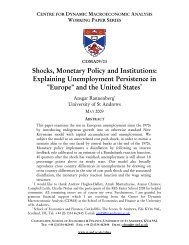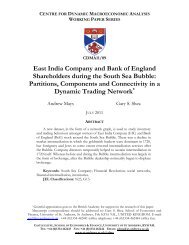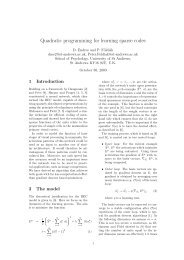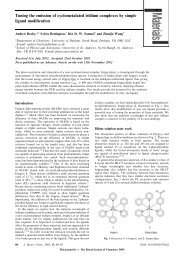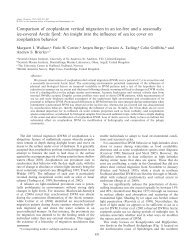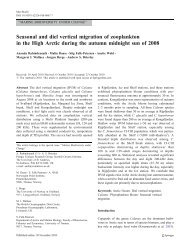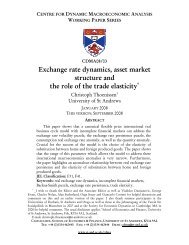Delay and Haircuts in Sovereign Debt - University of St Andrews
Delay and Haircuts in Sovereign Debt - University of St Andrews
Delay and Haircuts in Sovereign Debt - University of St Andrews
You also want an ePaper? Increase the reach of your titles
YUMPU automatically turns print PDFs into web optimized ePapers that Google loves.
We assume that the sovereign debtor issues a bond 12 at t = 0, which<br />
promises an <strong>in</strong>terest coupon, r, <strong>in</strong> perpetuity. At t = 0, the sovereign debtor<br />
has to choose the level <strong>of</strong> e¤ort 13 , e 2 [0; 1], at a cost (e), where 0 (e) > 0<br />
<strong>and</strong> 00 (e) > 0, so that it is more costly for the debtor to exert high e¤ort<br />
relative to low e¤ort. At the beg<strong>in</strong>n<strong>in</strong>g <strong>of</strong> t = 1, the sovereign debtor faces<br />
an adverse shock 14 with probability h. Conditional on the adverse shock,<br />
there is a default by sovereign debtor with probability 1 e due to a lack<br />
<strong>of</strong> available funds to cover outst<strong>and</strong><strong>in</strong>g debt payments. This suggests that a<br />
low e¤ort implies that the debtor’s economy is more likely to be vulnerable<br />
to an adverse external shock.<br />
The adverse shock occurs with a positive probability only at the beg<strong>in</strong>n<strong>in</strong>g<br />
<strong>of</strong> t = 1, <strong>and</strong> the probability <strong>of</strong> the adverse shock is zero <strong>in</strong> all<br />
subsequent periods. In the absence <strong>of</strong> the adverse shock, the debtor cont<strong>in</strong>ues<br />
to make any contracted repayments <strong>and</strong> obta<strong>in</strong>s a cont<strong>in</strong>uation, noncontractible<br />
payo¤ 15 (measured <strong>in</strong> t = 0 payo¤ units) <strong>of</strong> D > 0. The fact<br />
that the debtor’s payo¤, D, is non-contractible means that D cannot be<br />
attached by the private creditors <strong>in</strong> the settlement <strong>of</strong> their claims nor can<br />
the sovereign debtor make a credible commitment to transfer such payo¤ to<br />
the private creditors.<br />
If there is a default, the payo¤ <strong>of</strong> the debtor is described as <strong>in</strong> Section 2<br />
<strong>and</strong> will depend on whether there is one-period or two-period delay <strong>in</strong> the<br />
restructur<strong>in</strong>g <strong>of</strong> defaulted debts. As a function <strong>of</strong> the equilibrium prevail<strong>in</strong>g<br />
<strong>in</strong> the post-default debt restructur<strong>in</strong>g game, let K denote the debtor’s expected<br />
payo¤ conditional on default, measured <strong>in</strong> t = 0 payo¤ units, where<br />
K < D. The debtor faces the follow<strong>in</strong>g maximization problem:<br />
max h [eD + (1 e) K] + (1 h) D (e):<br />
e2[0;1]<br />
12 It is important to explicitly state that, <strong>in</strong> this model <strong>of</strong> ex ante debtor moral hazard,<br />
s<strong>in</strong>ce the debtor does not decide how much to borrow, there is no room for default to<br />
improve risk shar<strong>in</strong>g, <strong>and</strong> there is no <strong>in</strong>tensive marg<strong>in</strong> along which borrow<strong>in</strong>g can be<br />
adjusted to changes <strong>in</strong> the cost <strong>of</strong> borrow<strong>in</strong>g.<br />
13 In this context, high e¤ort could correspond to a situation where money is borrowed<br />
<strong>and</strong> used to promote R&D <strong>in</strong> the export sector <strong>and</strong> low e¤ort could correspond to transferr<strong>in</strong>g<br />
borrowed money to local elites who are then free to put it <strong>in</strong> tax havens overseas<br />
(see Ghosal <strong>and</strong> Miller (2003) for more examples <strong>of</strong> ex ante debtor moral hazard <strong>and</strong> other<br />
relevant results).<br />
14 An example <strong>of</strong> such adverse shock could be a shock to world oil prices.<br />
15 Follow<strong>in</strong>g Eaton <strong>and</strong> Gersovitz (1981), we <strong>in</strong>terpret this non-contractible payo¤ as<br />
the bene…t at t = 1 <strong>of</strong> a future ga<strong>in</strong> <strong>in</strong> national output when a debt crisis is prevented at<br />
t = 1.<br />
20



